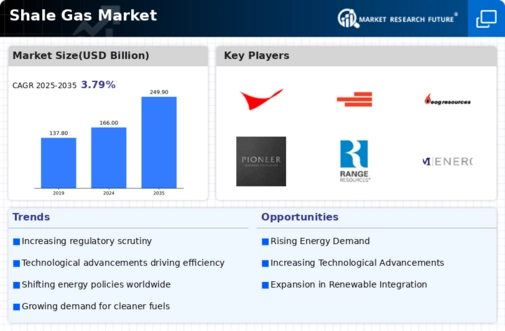Top Industry Leaders in the Shale Gas Market

*Disclaimer: List of key companies in no particular order
Shale Gas Company Dynamics: A Comprehensive Exploration of the Competitive Landscape
The shale gas market is a dynamic and fiercely competitive sector, influenced by a confluence of factors such as technological advancements, escalating demand, and a growing emphasis on environmental sustainability. This comprehensive report delves into the current competitive landscape, highlighting key players, their strategies, market share dynamics, and emerging trends that shape the future of this pivotal energy resource.
Key Players Shaping the Landscape:
In the realm of shale gas exploration and production, several influential players are leading the charge. Renowned industry titans, including Southwestern Energy Company, EQT Corporation, Equinor ASA, Repsol SA, SINOPEC/Shs, Chesapeake Energy Corporation, Royal Dutch Shell PLC, Exxon Mobil Corporation, Chevron Corporation, and PETROCHINA/Shs, stand out as pivotal entities steering the course of the market.
Strategies Driving Competitiveness:
The shale gas market is poised for sustained growth, driven by escalating global energy demand and the shift away from coal. The competition is expected to remain intense, with a focus on cost reductions, technological advancements, and diversification strategies. The competitive edge in the shale gas market is earned through a strategic blend of innovation, efficiency, and sustainability. Key strategies employed by industry leaders include:
Factors Influencing Market Share Analysis:
Environmental considerations will continue to be pivotal, compelling companies to adopt sustainable practices and address concerns related to their carbon footprint. Mergers and acquisitions will likely persist as companies seek to consolidate their positions and access new opportunities. Understanding the competitive landscape requires a thorough analysis of several factors:
New and Emerging Players:
Amidst the established giants, new and emerging players are making waves in the market:
Additional Insights:
- Regional Variation: The competitive landscape varies across regions due to geological factors, regulatory frameworks, and market dynamics.
- Technological Disruption: The advent of technologies such as artificial intelligence and data analytics has the potential to disrupt the market and create new opportunities for innovative players.
- Collaborative Efforts: Collaboration between governments, industry players, and academic institutions will be essential for developing sustainable shale gas production practices and mitigating environmental risks.
Company Updates
- Southwestern Energy Company (SWN)
December 8: Increased Capital Budget: SWN announces a 20% increase in its 2024 capital budget to focus on drilling and development activities in the Haynesville Shale and Marcellus Shale basins.
November 30: Strong Earnings: SWN reports third-quarter earnings per share (EPS) of $1.53, exceeding analysts' expectations of $1.42. The company also announces a 10% increase in its quarterly dividend.
- Equinor ASA
December 6: US Shale Gas Investment: Equinor announces plans to invest $1 billion in shale gas exploration and development in the United States.
November 28: Strong Earnings: Equinor reports third-quarter adjusted net income of $5.2 billion, exceeding analysts' expectations of $5.0 billion. The company attributes the strong performance to higher oil and gas prices.

